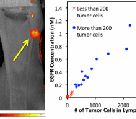 Optics in Medicine faculty & students have developed a new method of determining cancer stage and spread that is safer and potentially more accurate than conventional lymph node biopsy. The full technical report is published in the latest issue of Nature Medicine.
Optics in Medicine faculty & students have developed a new method of determining cancer stage and spread that is safer and potentially more accurate than conventional lymph node biopsy. The full technical report is published in the latest issue of Nature Medicine.
The report states, “Lymph node biopsy is employed in many cancer surgeries to identify metastatic disease and to determine cancer stage, yet morbidity and diagnostic delays associated with lymph node biopsy could be avoided if noninvasive imaging of nodal involvement were reliable.” This presents a new and improved method of noninvasive molecular imaging using a “dual-tracer” technique that corrects the problem of nonspecific uptake of imaging tracers that has made previous attempts at this approach clinically ineffective.
“This work summarizes the development of an imaging method that will allow oncologists to noninvasively detect microscopic levels of cancer spread to the lymphatic system in their patients,” says lead author Kenneth Tichauer, engineering professor at Illinois Institute of Technology and former Thayer School post-doc. “Cancer spread [metastasis] is the principal cause of mortality for cancer sufferers, and in an effort to characterize the metastatic potential of a patient’s disease, surgeons often remove tumor draining lymph nodes for analysis during surgical resection of the primary tumor. Such procedures can result in significant morbidity, yet the majority of lymph nodes are found to be free of cancer spread.” – See more at: Lymph Node Cancer Detection.